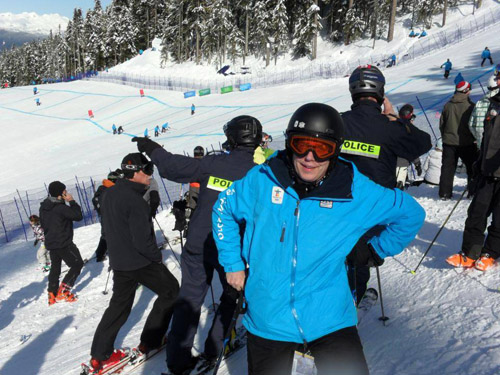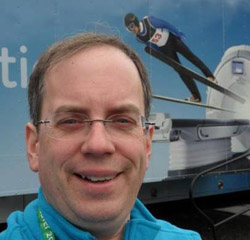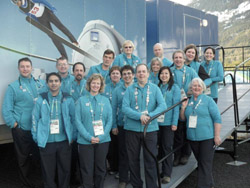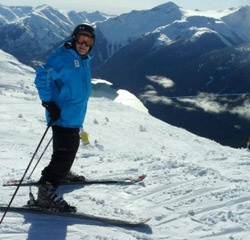Olympic Surgeon
UCSD Trauma Doctor Treats Injured Athletes at Winter Games
Ioana Patringenaru | February 22, 2010
 UCSD surgeon Jay Doucet poses in front of the women's downhill course at Whistler Moutnain. UCSD surgeon Jay Doucet poses in front of the women's downhill course at Whistler Moutnain. During his second day in Vancouver, UC San Diego surgeon Jay Doucet got word that a horrific accident had taken place on the luge track at Whistler Mountain, the Olympic site where most high-speed events are held.
The news hit close to home for Doucet, who came to Canada to work as a volunteer trauma physician at the Olympic Winter Games. He was due to start work the next day in the Medical Mobile Unit where the Georgian luge competitor Nodar Kumaritashvili, 21, was pronounced dead after bouncing off a sidewall of the track and slamming into a steel pole. Doucet’s stint at the Olympics ends today.
“We all felt horribly about it — to see such a young man killed at an event so many athletes, volunteers and others had worked towards seeing succeed,” Doucet wrote in an e-mail from Vancouver.
Doucet and his fellow physicians and nurses working in the unit spent much of the rest of their 12-day shift hoping a similar incident wouldn’t happen again. So far, they have gotten their wish. Several athletes have been treated for trauma and airlifted to Vancouver, but no one has lost their life.
“Watching events like the men’s downhill and women’s luge, we were keenly aware that any crash could result in a trauma admission within minutes,” Doucet wrote in an e-mail from Whistler Mountain. “We have seen athletes with less serious injuries, and it is very obvious that the pressure to succeed and sense of loss with a defeat often hurts more than any physical injury.”
Treating athletes
Doucet saw one example of the athletes’ dedication when he and his colleagues treated Petra Majdic, a Slovenian cross-country skier. Majdic suffered a dramatic fall on a training run before her race, tumbling 10 feet into a creek and breaking several ribs. She also suffered a collapsed lung. In spite of the pain, the skier still took part in the race and won a bronze medal, her country’s first individual medal since 1994.
It was only after the race that she finally came into the mobile unit for treatment. Still, she wanted to attend the race’s medal ceremony. Doucet’s colleague, Dr. Kosar Khwaja, a trauma surgeon from McGill University, escorted her there. She then was transferred to Vancouver for further treatment. Majdic came back at the end of the week to thank the surgeons and gave the unit’s nurses her bouquet from the medal ceremony.
 Doucet shows off some of the Olympic pins he collected during the Winter Games. Doucet shows off some of the Olympic pins he collected during the Winter Games.
“The big issue when treating athletes is prohibited medications, Doucet wrote. Many prescriptions are disqualifying and even a simple IV fluid can generate problems. Of course, this isn’t an issue in life-threatening cases. But several athletes have been airlifted off the slopes only to discover in the medical unit that they had minor injuries. In that case, physicians conferred with doping officials before putting the victims on an IV.
The need for on-site trauma care at the Winter Olympics became clear after an incident during a ski competition in Norway. An athlete severely injured his leg and because he couldn’t get prompt treatment at the site or nearby, had to undergo an amputation. As a result, officials decided to set up a mobile medical unit right in the athletes’ village at Whistler, where most ski, luge, bobsled and skeleton competitions are taking place.
Why volunteer?
Doucet, who has deployed as a trauma physician to Afghanistan and Bosnia, said he decided to volunteer his services for the Olympics because he yearned to work in the field. He now heads UCSD’s surgical intensive care unit. The Olympic experience also is meaningful to him because he is a Canadian citizen. He is also a skier, who has barreled down the slopes at Whistler Mountain. In addition, he has worked in the area when he served in the Canadian military.
“We’re there to support the games that I think are going to be exciting and a lot of fun,” Doucet said.
He says he believes he was selected to serve because UCSD’s reputation for top-notch trauma care extends beyond U.S. borders. More specifically, many Canadian trauma surgeons have trained on campus. Vancouver’s regional trauma director, Dr. Richard Simons, was on the UCSD faculty.
Celebrity sightings
When he wasn’t treating Olympians, staff and volunteers, Doucet got to watch several races, including the women’s downhill, won by American Lindsey Vonn. He also got to meet celebrities, including Howie Mandel and England’s Princess Anne, in addition to several top-notch athletes.
 The Medical Mobile Unit team. The Medical Mobile Unit team.
Celebrity sightings started early on. Mandel got off the same plane as Doucet. He was very friendly and signed autographs, Doucet wrote in an e-mail. The physician even got to talk to the comedian and TV personality, who said he was excited to be back in Canada for the Olympic Games. “He reminded me he was Canadian, but of course we all knew that,” Doucet wrote. On the same day, Doucet caught a glimpse of Wayne Gretzky lighting the Olympic cauldron during the opening day ceremonies.
The following day, Princess Anne and the president of Latvia, Valdis Zatlers, came by the athletes’ village polyclinic. They decided not to enter the facility because they worried their entourages would disturb the clinic’s services, Doucet wrote. On Sunday, the king and queen of Sweden paid a visit.
Also visiting was the Governor-General Michaelle Jean, who acts as the crown in Canada in the absence of the queen. “Her role is mostly ceremonial, but she spends much of her time trying to promote good causes to Canadians and improve the lot of the disadvantaged,” Doucet wrote. “She was originally a writer and journalist in the French-Canadian media, and her efforts have extra poignancy as she is originally a native of Haiti. She was here to cheer on all the athletes.”
 Doucet gets ready to hit the slopes at Whistler Mountain. Doucet gets ready to hit the slopes at Whistler Mountain.
Olympic competition
Doucet said he was impressed by the Olympic spirit presiding over the games. Many cheered on athletes from other nations. Olympians also seemed to make a sport of exchanging jerseys and Olympic pins. “The Canadian red maple leaf mittens are very popular and have been spotted on several other teams,” he wrote.
Last week, he got a first-hand look at an Olympic competition, the women’s downhill. He and two colleagues skied to the top of the mountain, then stationed themselves one-third of the way down the course. “The speeds of the women today were incredible, they were passing us at about 75 mph,” Doucet wrote. Several athletes were injured and flown off the mountain, but the UCSD physician didn’t see the crashes.
“After six hours on the hill, I was exhausted,” he wrote. “It took me about 30 minutes to ski down what the Olympians did in about 1 minute 45 seconds.”

|